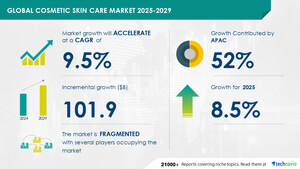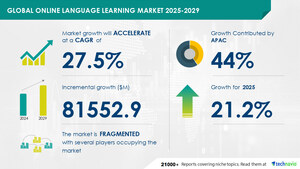NEW YORK, Nov. 18, 2024 /PRNewswire/ -- Report with the AI impact on market trends - The global composite decking market size is estimated to grow by USD 2.82 billion from 2024-2028, according to Technavio. The market is estimated to grow at a CAGR of 14.04% during the forecast period. Revival of construction industry is driving market growth, with a trend towards rising adoption of prefabricated construction solutions. However, availability of substitutes for composite decking poses a challenge.Key market players include APR Composites, Buyrite Enterprises Ltd., Compagnie de Saint Gobain, DuraLife Decking and Railing Systems, Fortress Iron LP, Fortune Brands Innovations Inc., Genova Products Inc., Green Bay Decking, Nanjing Xuhua Sundi New Building Materials Co. Ltd., NewTechWood America Inc., Oakio Plastic Wood Building Materials Co. Ltd., Shanghai Seven Trust Industry Co. Ltd., Shubh Composites, TAMKO Building Products LLC, The AZEK Co. Inc., Trex Co. Inc., TruNorth International Corp., UFP Industries Inc., UPM Kymmene Corp., and Wallong Technology Co. Ltd..
Key insights into market evolution with AI-powered analysis. Explore trends, segmentation, and growth drivers- View Free Sample PDF
Composite Decking Market Scope |
|
Report Coverage |
Details |
Base year |
2023 |
Historic period |
2018 - 2022 |
Forecast period |
2024-2028 |
Growth momentum & CAGR |
Accelerate at a CAGR of 14.04% |
Market growth 2024-2028 |
USD 2.82 billion |
Market structure |
Fragmented |
YoY growth 2022-2023 (%) |
13.5 |
Regional analysis |
North America, Europe, APAC, South America, and Middle East and Africa |
Performing market contribution |
North America at 32% |
Key countries |
US, Canada, China, UK, and Germany |
Key companies profiled |
APR Composites, Buyrite Enterprises Ltd., Compagnie de Saint Gobain, DuraLife Decking and Railing Systems, Fortress Iron LP, Fortune Brands Innovations Inc., Genova Products Inc., Green Bay Decking, Nanjing Xuhua Sundi New Building Materials Co. Ltd., NewTechWood America Inc., Oakio Plastic Wood Building Materials Co. Ltd., Shanghai Seven Trust Industry Co. Ltd., Shubh Composites, TAMKO Building Products LLC, The AZEK Co. Inc., Trex Co. Inc., TruNorth International Corp., UFP Industries Inc., UPM Kymmene Corp., and Wallong Technology Co. Ltd. |
Market Driver
Composite decking is a popular choice for homeowners and contractors seeking weather-resistant, low-maintenance outdoor living solutions. The market for composite decking is thriving, with varieties like capped composite decking offering a protective shell against fading, staining, and scratching. Homeowners appreciate the load-bearing capacity and resistance to foot traffic, making it an ideal option for high-use areas. Industry executives report a shift in trend towards composite decking, as more clients seek sustainable options. Capped composite decking comes in various color options and resin types, including PVC and HDPE. The form and segmentation of composite decking include railings, which offer low thermal expansion and resistance to slip. However, raw material costs and regulatory harvesting concerns can be restraining factors. Notable players in the market include Cardinal Building Products, Green Bay Decking, Fiberon, and MoistureShield. In interviews with industry associations, executives discuss the rise in demand for composite decking, with some offering luxury lines like Transcend Lineage. The bottom line: composite decking offers design flexibility, sustainability, and durability, making it a top choice for building and construction projects.
The prefabricated construction industry, specifically composite decking, is experiencing significant growth due to its cost-effective and time-saving advantages. In this process, various building components are manufactured in a controlled environment and transported to the construction site for assembly. Quality and design standards are key priorities in prefabricated construction to address the challenges of site-built homes. New prefabricated buildings often surpass conventional residences in aspects such as durability and energy efficiency. Compliance with codes such as the US Housing and Urban Development (HUD) Code or the International Residential Code (IRC) ensures safety and reliability.
Request Sample of our comprehensive report now to stay ahead in the AI-driven market evolution!
Market Challenges
- Composite decking is a popular choice for homeowners and contractors seeking low-maintenance, weather-resistant outdoor living solutions. However, the market faces challenges. Capped composite decking, with its protective shell, addresses concerns of fading, staining, and scratching. Yet, load-bearing capacity and foot traffic can be restricting factors. Homeowners value color options and resistance to slip, while contractors prioritize load-bearing capacity and low thermal expansion. Sustainability is a growing concern, with industry associations advocating for eco-friendly resin types. Executives from leading brands like Cardinal Building Products, Green Bay Decking, Fiberon, and MoistureShield share insights. Data triangulation reveals a shift in trend from natural wood to composite decking. Raw material costs and product offerings impact the bottom line. The rise in demand for composite decking railing and luxury lines, such as Transcend Lineage, presents opportunities. Harvesting and regulatory issues can pose restraining factors. Understanding resin types, form, and segmentation is crucial for success in the building and construction industry.
- Composite decking is a popular choice for exterior home decoration due to its durability and attractive appearance. However, concrete flooring is an affordable alternative that can withstand heavy stress and pressure. Although the surface of concrete is not as smooth as composite or timber, it is a cost-effective option that can last longer with proper maintenance. Tiles and fiber cement decking are other alternatives, each offering unique benefits. Tiles can be customized for aesthetic appeal, while cement decking provides good resistance to heat and moisture, making it suitable for hot and humid climates. The demand for these alternatives may be lower than composite decking, but their wide availability and affordability are increasing their popularity.
Discover how AI is revolutionizing market trends- Get your access now!
Segment Overview
This composite decking market report extensively covers market segmentation by
- Application
- 1.1 Residential
- 1.2 Non-residential
- Type
- 2.1 Polyethylene
- 2.2 Polypropylene
- 2.3 Polyvinyl chloride
- 2.4 Others
- Geography
- 3.1 North America
- 3.2 Europe
- 3.3 APAC
- 3.4 South America
- 3.5 Middle East and Africa
1.1 Residential- The residential segment of the composite decking market is anticipated to experience significant growth due to the increase in residential construction activities in the US, Europe, and Asia Pacific (APAC) regions. Factors such as increasing disposable incomes, urbanization, and government initiatives are driving the demand for new residential constructions and public infrastructure in countries like China, India, Malaysia, and Indonesia. The recovery of the global housing market in the US, Canada, Germany, and Spain is also expected to fuel the demand for composite decking. In the US, the residential building industry has benefited from expansionary monetary policies and record-low mortgage rates, leading to an increase in housing demand. Additionally, growing investments by countries like the US and Germany for remodeling and renovation of residential buildings will further boost the market growth. The Middle Eastern region, particularly the UAE, is also witnessing in residential construction activities, with projects like Azizi Developments' Riviera Reve in Dubai, which includes 25 luxury buildings and over 5,000 houses, contributing to the market expansion. Despite the temporary halt of residential construction activities due to COVID-19 lockdowns, the long-term growth prospects of the market remain positive, driven by the factors mentioned above.
Download a Sample of our comprehensive report today to discover how AI-driven innovations are reshaping competitive dynamics
Research Analysis
Composite decking is a popular choice for homeowners and contractors due to its durability and low maintenance properties. This building material is made from a combination of natural wood fibers and plastic resins, creating varieties such as capped composite decking with a protective shell. While initial costs may be higher than natural wood, composite decking offers benefits like resistance to fading, staining, scratching, and high load-bearing capacity. Resin types used in composite decking include polyethylene and polypropylene, with a shift in trend towards the latter due to its superior performance. Composite decking railing is also available, offering a cohesive look for outdoor spaces. Other advantages include low thermal expansion, resistance to slip, and color stability. Raw material costs and segmentation, including form (solid or hollow), have influenced product offerings from companies like Cardinal Building Products, Green Bay Decking, Fiberon, and MoistureShield. The building and construction industry has seen a rise in demand for composite decking due to its benefits, while the requirement for natural wood is lessening due to harvesting and regulatory concerns.
Market Research Overview
Composite decking is a popular choice for homeowners and contractors seeking low-maintenance, weather-resistant solutions for their outdoor living spaces. This market offers various varieties, including capped composite decking with a protective shell, to ensure durability against fading, staining, scratching, and high foot traffic. Composite decking is known for its load-bearing capacity and resistance to slip, making it an ideal option for both residential and commercial projects. The shift in trend towards sustainable materials has boosted the composite decking market. Resin types, form, and segmentation are key factors influencing product offerings. Capped composite decking, with its low thermal expansion and color stability, is a top choice for clients seeking design versatility. However, raw material costs and color fading can be restraining factors. Interviews with industry executives reveal a rise in demand for composite decking railings and luxury lines. The Building and Construction Industry Association and other industry associations provide valuable data triangulation on market trends. The Transcend Lineage and other luxury composite decking lines cater to the growing demand for high-end, long-lasting outdoor living solutions.
Table of Contents:
1 Executive Summary
2 Market Landscape
3 Market Sizing
4 Historic Market Size
5 Five Forces Analysis
6 Market Segmentation
- Application
- Residential
- Non-residential
- Type
- Polyethylene
- Polypropylene
- Polyvinyl Chloride
- Others
- Geography
- North America
- Europe
- APAC
- South America
- Middle East And Africa
7 Customer Landscape
8 Geographic Landscape
9 Drivers, Challenges, and Trends
10 Company Landscape
11 Company Analysis
12 Appendix
About Technavio
Technavio is a leading global technology research and advisory company. Their research and analysis focuses on emerging market trends and provides actionable insights to help businesses identify market opportunities and develop effective strategies to optimize their market positions.
With over 500 specialized analysts, Technavio's report library consists of more than 17,000 reports and counting, covering 800 technologies, spanning across 50 countries. Their client base consists of enterprises of all sizes, including more than 100 Fortune 500 companies. This growing client base relies on Technavio's comprehensive coverage, extensive research, and actionable market insights to identify opportunities in existing and potential markets and assess their competitive positions within changing market scenarios.
Contacts
Technavio Research
Jesse Maida
Media & Marketing Executive
US: +1 844 364 1100
UK: +44 203 893 3200
Email: [email protected]
Website: www.technavio.com/
SOURCE Technavio

WANT YOUR COMPANY'S NEWS FEATURED ON PRNEWSWIRE.COM?
Newsrooms &
Influencers
Digital Media
Outlets
Journalists
Opted In





Share this article